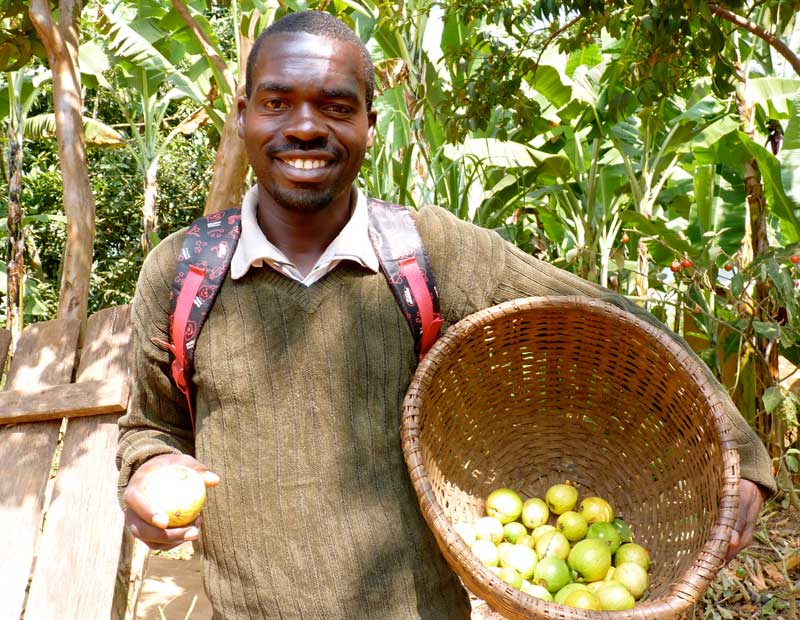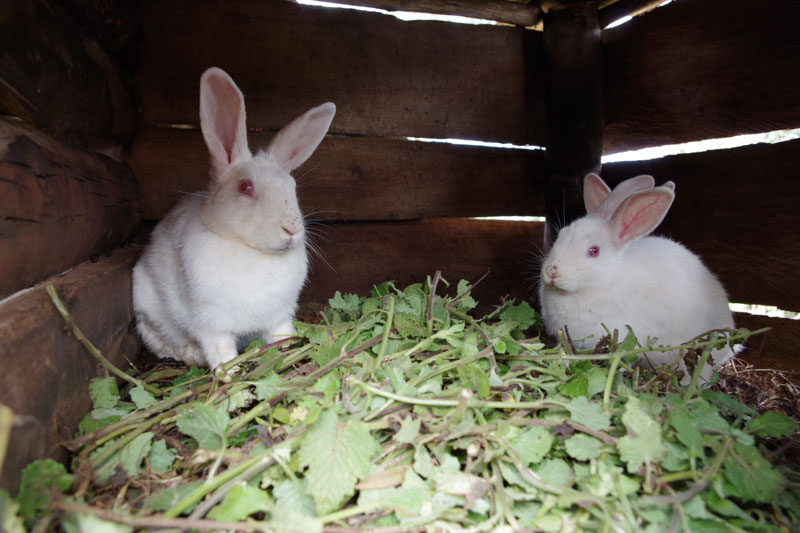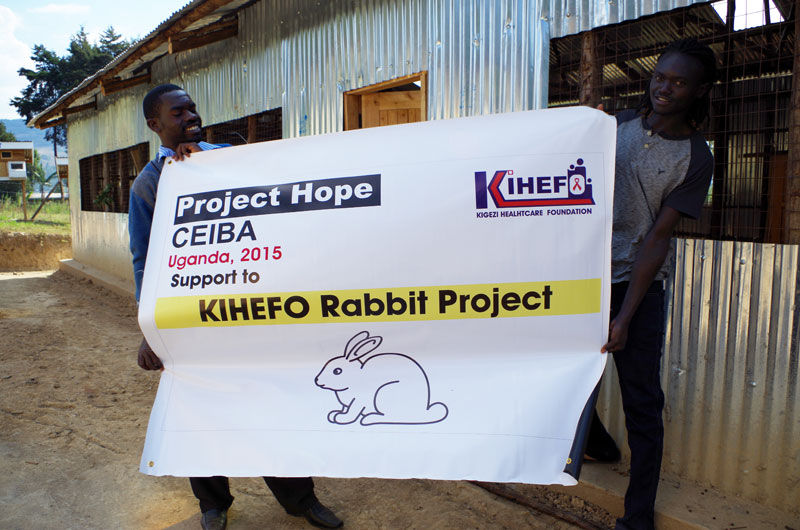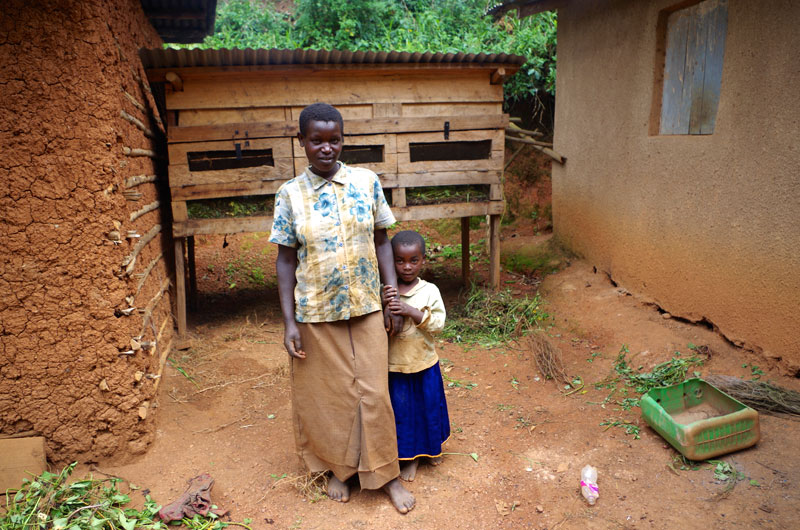Rabbits: Cute, Cuddly, and Capable of Feeding Villages
How one young agrarian is betting on a home-grown solution to poverty and malnutrition.
Rabbits: Cute, Cuddly, and Capable of Feeding Villages
How one young agrarian is betting on a home-grown solution to poverty and malnutrition.

The Gates Foundation funds research on engineering new genetically modified-varieties of staple crops – including rice, sweet potatoes, and bananas – to contain higher amounts of vitamins and nutrients. Many development organizations, including the Alliance for Green Revolution in Africa, distribute what they call “improved seeds,” or hybrid and genetically modified seeds, with promises of higher yields and financial returns for poor farmers.
But the solutions to child malnutrition aren’t always dependent on money, GMOs, or Western expertise, argues Alphonse Twinamatsiko, a farmer and sustainable agriculture technician from southwestern Uganda. Twinamatsiko works as a consultant for various community-based organizations, including Go Organic Africa. “We have everything we already need to address malnutrition,” he says.
Rather than importing ideas from Western countries, Twinamatsiko is looking no further than his own backyard where a simple wooden cage, built for less than $50, houses one male and two female rabbits.
The 29-year-old was born and raised in the Kabale District in southwestern Uganda where more than 60 percent of the population practices small-scale agriculture. Farmers grow indigenous varieties of sorghum, sweet potatoes, cowpeas, beans, and maize. While many also raise goats and chickens, livestock is rarely eaten, but rather reserved as a sort of “living bank account” and sold to pay for school fees, land, and medical emergencies.
“Most families only eat meat once or twice a year,” says Twinamatsiko, “usually during religious holidays like Christmas and Eid, or at weddings and burials.”
As a result of this carbohydrate-heavy diet, UNICEF estimates that 45 percent of children under five years old in Kabale are experiencing forms of malnutrition. One of the most common kinds is kwashiorkor, an energy-protein deficiency caused by the lack of protein, iron, and vitamin B12. Kwashiorkor can lead to stunted growth and development, and the World Health Organization estimates malnutrition is the underlying cause of 45 percent of all child deaths, worldwide.
But why rabbits?


In 2012, Twinamatsiko completed a diploma in sustainable agriculture and rural development at Baraka Agricultural College in Molo, Kenya. While there, he learned about intensive rabbit breeding. Although Twinamatsiko raised the animals recreationally as a child, he never considered it a serious venture. At Baraka College, however, he had the opportunity to visit household and larger-scale rabbit breeding projects and learn about their benefits. Inspired by his experiences, Twinamatsiko returned to southwestern Uganda with the goal to promote rabbit breeding.
There’s a good reason for the expression “breed like rabbits.” One doe can give birth to four to six litters every year, producing upwards of 60 offspring. That’s a huge return for poor farmers who rarely eat meat.
Rabbits are an ideal meat-source for poor farmers in Kabale for a variety of reasons, Twinamatsiko argues. The majority of farmers can’t afford to buy grain feed in the market to raise chickens, nor do they have enough land to graze cattle. Instead, rabbits can be fed on weeds and wild vegetation, which are locally available and affordable to farmers. Secondly, disease vulnerability and mortality rates are lower in rabbits than chickens, especially when they’re kept in elevated cages. And finally, there’s a good reason for the expression “breed like rabbits.” Twinamatsiko says that one doe can give birth to four to six litters every year, producing upwards of 60 offspring. That’s a huge return for poor farmers who rarely eat meat.
In 2013, Twinamatsiko teamed up with a local medical doctor, Dr. Anguyo Geoffrey, who runs a community healthcare organization called the Kigezi Healthcare Foundation (KIHEFO). Dr. Anguyo regularly identifies cases of extreme malnutrition in southwestern Uganda. He admits sick children and their caretakers for rehabilitation treatment at KIHEFO’s clinic in Kabale. Together, Twinamatsiko and KIHEFO began developing a rabbit-breeding program with the goal to supply rabbit stock to poor farmers with vulnerable children. In May 2015, KIHEFO built a Rabbit Breeding Center in Kabale, and Twinamatsiko rolled up his sleeves and got to work in the community.


There are now more than 300 rabbits at the center, including Californian, New Zealand, and Flemish Giant, which are typically bred for meat. Through KIHEFO’s development programing, poor households receive three animals (two does and one buck) and training, which enables them to start their own projects. To date, more than 100 farmers have begun breeding rabbits in their backyards.
Emily Ninsiima, 28 years old, is a small-scale farmer who lives in the village of Kicumbi. She’s a single mother to two young daughters. In 2014, she received support from Twinamatsiko and KIHEFO to raise rabbits.

“It’s made a big difference,” says Ninsiima, whose rabbit population grew quickly. Over the course of a year, she tripled her family’s meat intake. She sold five of the rabbits, generating additional income and gave away a few to her neighbors so they could start their own projects. “It’s doesn’t take much time to feed and care for them,” explains Ninsiima, “and the risk of failure is low.” She also points out that rabbits produce a large amount of manure, which she processes into organic compost and fertilizer for her field crops.
Today Twinamatsiko isn’t only training farmers how to raise rabbits – he’s building new markets and buying back the surplus at a guaranteed price. A few months ago, he opened the first “Rabbit Joint” (restaurant) in Kabale town, serving a signature dish of roasted rabbit, cabbage coleslaw, and steamed plantain. He admits that it’s been challenging to convince the public that rabbit meat can be just as tasty and desirable as other more preferred meats, like goat and pork.
But working to change the cultural palate is all part of Twinamatsiko’s greater task to support sustainable solutions to child malnutrition, food security and economic development in Uganda.
“As a farmer, you have to be creative. You have to be innovative,” he says.
Follow us
This work is licensed under a Creative Commons Attribution-NoDerivatives 4.0 International License.
Want to republish a Modern Farmer story?
We are happy for Modern Farmer stories to be shared, and encourage you to republish our articles for your audience. When doing so, we ask that you follow these guidelines:
Please credit us and our writers
For the author byline, please use “Author Name, Modern Farmer.” At the top of our stories, if on the web, please include this text and link: “This story was originally published by Modern Farmer.”
Please make sure to include a link back to either our home page or the article URL.
At the bottom of the story, please include the following text:
“Modern Farmer is a nonprofit initiative dedicated to raising awareness and catalyzing action at the intersection of food, agriculture, and society. Read more at <link>Modern Farmer</link>.”
Use our widget
We’d like to be able to track our stories, so we ask that if you republish our content, you do so using our widget (located on the left hand side of the article). The HTML code has a built-in tracker that tells us the data and domain where the story was published, as well as view counts.
Check the image requirements
It’s your responsibility to confirm you're licensed to republish images in our articles. Some images, such as those from commercial providers, don't allow their images to be republished without permission or payment. Copyright terms are generally listed in the image caption and attribution. You are welcome to omit our images or substitute with your own. Charts and interactive graphics follow the same rules.
Don’t change too much. Or, ask us first.
Articles must be republished in their entirety. It’s okay to change references to time (“today” to “yesterday”) or location (“Iowa City, IA” to “here”). But please keep everything else the same.
If you feel strongly that a more material edit needs to be made, get in touch with us at [email protected]. We’re happy to discuss it with the original author, but we must have prior approval for changes before publication.
Special cases
Extracts. You may run the first few lines or paragraphs of the article and then say: “Read the full article at Modern Farmer” with a link back to the original article.
Quotes. You may quote authors provided you include a link back to the article URL.
Translations. These require writer approval. To inquire about translation of a Modern Farmer article, contact us at [email protected]
Signed consent / copyright release forms. These are not required, provided you are following these guidelines.
Print. Articles can be republished in print under these same rules, with the exception that you do not need to include the links.
Tag us
When sharing the story on social media, please tag us using the following: - Twitter (@ModFarm) - Facebook (@ModernFarmerMedia) - Instagram (@modfarm)
Use our content respectfully
Modern Farmer is a nonprofit and as such we share our content for free and in good faith in order to reach new audiences. Respectfully,
No selling ads against our stories. It’s okay to put our stories on pages with ads.
Don’t republish our material wholesale, or automatically; you need to select stories to be republished individually.
You have no rights to sell, license, syndicate, or otherwise represent yourself as the authorized owner of our material to any third parties. This means that you cannot actively publish or submit our work for syndication to third party platforms or apps like Apple News or Google News. We understand that publishers cannot fully control when certain third parties automatically summarize or crawl content from publishers’ own sites.
Keep in touch
We want to hear from you if you love Modern Farmer content, have a collaboration idea, or anything else to share. As a nonprofit outlet, we work in service of our community and are always open to comments, feedback, and ideas. Contact us at [email protected].by Trina Moyles, Modern Farmer
January 12, 2016
Modern Farmer Weekly
Solutions Hub
Innovations, ideas and inspiration. Actionable solutions for a resilient food system.
ExploreExplore other topics
Share With Us
We want to hear from Modern Farmer readers who have thoughtful commentary, actionable solutions, or helpful ideas to share.
SubmitNecessary cookies are absolutely essential for the website to function properly. This category only includes cookies that ensures basic functionalities and security features of the website. These cookies do not store any personal information.
Any cookies that may not be particularly necessary for the website to function and are used specifically to collect user personal data via analytics, ads, other embedded contents are termed as non-necessary cookies.
Great idea